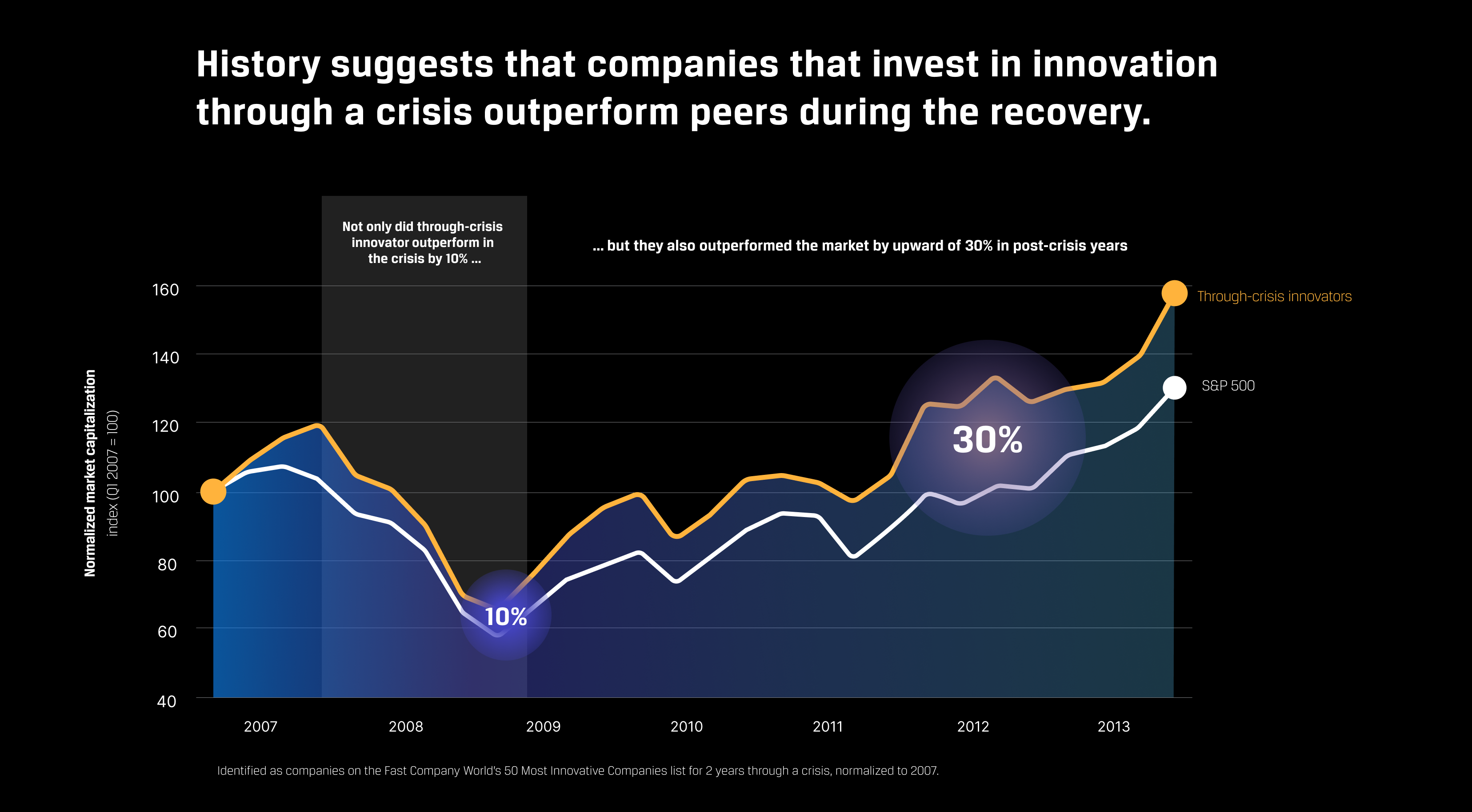
As we enter 2023, predictions of recession seem to dominate everything we read or hear. While officials avoid using the word, high interest rates, tech layoffs, and falling earnings certainly spur recessionary fear. But should it? History tells us that downturns are often ripe with opportunity for innovation that not only helps companies weather the economic storm, but that positions them to emerge from it stronger.
The typical business response in a downturn comes from the CFO. Looking at the problem from a different lens, however, reveals opportunity. We believe that the role of the strategy group is just as essential. Right now, we are working with clients to prioritize innovation strategies for 2023. What’s consistent is a need to evaluate and re-evaluate priorities. Through this process, we’ve found some effective ways to measure opportunity, evaluate projects and prioritize.

Public health scientist running a sequencing machine. CDC/ Daniel Drapeau
Innovation During Recession Pays Dividends
Innovation during recessions has produced today’s highly valued, highly competitive companies and products. From Microsoft (founded in 1975 during the oil embargo recession), Electronic Arts (1982), iRobot (1990), to Airbnb (2008), Slack, WhatsApp, Square, Uber (2009), and even Instagram and Pinterest (2010). It’s not only Unicorns that seem to be borne of economic crisis. Companies that carefully evaluate and prioritize innovation outperform competitors during the low-point of the crisis, but also as conditions improve.

A global research study in 2020 found that companies that prioritized innovation during the 2008-2009 global financial crisis outperformed market averages by 10% in the depth of the crisis, and by 30% as the crisis eased. What’s more, they continued to experience growth in the following years. The same is true today. Another industry study found that companies that invested in tech innovation during the Covid-19 crisis are now growing at a 5x faster rate than their competitors.
Human centered design is an essential part of innovation because it brings digital products closer to actual users.
Focus Innovation on Meaningful Customer Choices and Experiences
It’s in Puncucut’s ethos to prioritize people and evaluate technology with an eye to the future. According to Forrester Research, companies that prioritize human centered UX design are rewarded by increased customer loyalty, better stock performance, higher revenues, and larger valuations. In times of pressure, customers expect more and spend less, so every interaction must be valuable to them. Human-centered design can ensure that products are intuitive and fluid, and meet customer expectations. There is no better time than now to reevaluate customer needs and emotions, and find empathy for customers’ fears. After all, it’s their business that is at stake too!
We are working with clients to appraise changing customer sentiment after the last 24-month period of economic growth. Through researching and modeling the user journey, we are discovering what is essential and what can be left out of the design for efficiency and effectiveness. Data is helping us uncover insight into product designs that create meaningful value and help customers feel successful, hopeful, and productive. And, we’re also designing features and approaches that customers can’t live without while moving away from unnecessary digital clutter.
Our design acceleration process begins with research. Through research, we know that innovation around value, efficiency, productivity, and community is resonating right now. Giving customers meaningful choices that help them find new benefits in existing digital products and services is important to keeping them in the future. Community is also increasingly important during downturns. Companies that find ways to enable customers to connect by designing community capabilities are providing value that many users care about, again keeping them engaged.
We firmly believe that customer research can guide companies to allocate innovation budgets to areas that provide the most value to customers. This insight is critical to current revenue streams, but it is a key to emerge strong when the upturn begins.
Build a Balanced Innovation Investment Portfolio
Investing in innovation during a recession sounds good, but how do you choose where to invest limited resources? Attack innovation like survival. Determine what is essential to your customers now and calibrate current innovation investments against future growth opportunities. Building a research-based innovation portfolio can help you meet current customer needs, position your company for future growth opportunities, and help you out maneuver your competition during and after the economic downturn.
Using a common first horizon, second horizon, and third horizon strategy is a good way to build an innovation investment portfolio. Evaluating investment opportunities against these horizons helps to prioritize and balance the portfolio.
- First Horizon: Innovation that aligns with immediate customer needs and attitudes. First horizon investments prioritize securing current revenues.
- Second horizon: 18-24 months out, anticipate post-recession customer needs and build competitive advantages with innovation that will help customers emerge from the downturn successfully.
- Third horizon: Limited investments that lay the foundation for future growth and scale in differentiated capabilities, products, services, and completely new inventions.
In a recession, adjust investments to be sure that you’re maximizing first and second horizons while reserving some investment for third horizon innovation opportunities. Most of our large clients are using a guideline of 70%-20%-10%. Smaller companies may want to invest 85%-10%-5%. The bottom line is that investment in innovation not only secures current revenue, it positions you for future success.
Five Actions You Can Take Now
Innovation is the engine that drives business and separates those companies that survive and thrive from the ones that don’t. The key to solid innovation investments lies in research and data to truly understand current customer needs, emotions and attitudes during the downturn, but with an eye to what will be important to them as the climate improves.
- Design true value into each product or new innovation – Use data to pinpoint and solve a current customer problem while accounting for their attitudes and challenges in the current environment. Designers must build in customer meaningful choices, capabilities, and functionality in products and services.
- Build an Innovation Portfolio – Reframe investments to focus on value creation for immediate, medium and long-term product horizons. Double down on first horizon products to maintain customers and emerge stronger than competitors.
- Engage communities of like-minded people and customers – Define the benefit or value of your innovation beyond the immediate customer to the larger community, environment, world. This will create awareness and preference for your product or service.
- Design new routes to market. Innovation in applications, websites, and product ecosystems may uncover new opportunities for growth. Consider the individual customer, groups of customers, and communities that are built around products and services to extend market reach. Design opportunities for a community of users to connect to extend a product’s reach and popularity.
- Act now. Recessionary periods are part of the modern global economy. History shows that those companies that continue to innovate, focusing on primary customer needs, are the ones that emerge in the strongest position post downturn.
Bottom Line
Over our two decades in business, we’ve worked with clients in the highest of economic times and some of the most challenging economic times. With our clients, we’ve learned a lot. We expect 2023 to have many familiar, and many new challenges. No matter the economic climate, our clients’ ability to use human centered design to meet the needs of the user remains paramount. In challenging times, our clients that anticipate and meet their users’ needs tend to be the ones that emerge with the most positive results.
It’s no surprise that we believe that innovation is critical during periods of uncertainty. The trick is to understand the impact of innovation on the business in the short, medium and longer term. And to do this, it’s critical that companies understand, at a deep level, the short term and longer term needs, preferences, and attitudes of their customers. We are looking forward to meeting the challenge head on in 2023.
Italic Lorem Ipsum
Body lorem ipsum dolor sit amet, consectetur adipiscing elit. Lorem ipsum dolor sit amet, consectetur adipiscing elit. Lorem ipsum dolor sit amet, consectetur adipiscing elit.
Body lorem ipsum dolor sit amet, consectetur adipiscing elit. Lorem ipsum dolor sit amet, consectetur adipiscing elit. Lorem ipsum dolor sit amet, consectetur adipiscing elit.

Caption lorem ipsum dolor sit amet, consectetur adipiscing elit.
Body lorem ipsum dolor sit amet, consectetur adipiscing elit. Lorem ipsum dolor sit amet, consectetur adipiscing elit. Lorem ipsum dolor sit amet, consectetur adipiscing elit.
Body lorem ipsum dolor sit amet, consectetur adipiscing elit. Lorem ipsum dolor sit amet, consectetur adipiscing elit. Lorem ipsum dolor sit amet, consectetur adipiscing elit.
Body lorem ipsum dolor sit amet, consectetur adipiscing elit. Lorem ipsum dolor sit amet, consectetur adipiscing elit. Lorem ipsum dolor sit amet, consectetur adipiscing elit.
“Pull Quote lorem ipsum dolor sit amet, consectetur adipiscing elit. Lorem ipsum dolor sit amet.”
— Lorem Ipsum
A Punchcut Perspective
Contributor: Ken Olewiler
© Punchcut LLC, All rights reserved.



